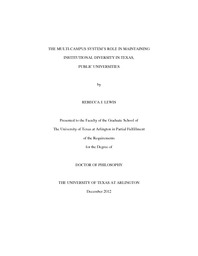
ATTENTION: The works hosted here are being migrated to a new repository that will consolidate resources, improve discoverability, and better show UTA's research impact on the global community. We will update authors as the migration progresses. Please see MavMatrix for more information.
Show simple item record
| dc.contributor.author | Lewis, Rebecca J. | en_US |
| dc.date.accessioned | 2013-03-20T19:13:38Z | |
| dc.date.available | 2013-03-20T19:13:38Z | |
| dc.date.issued | 2013-03-20 | |
| dc.date.submitted | January 2012 | en_US |
| dc.identifier.other | DISS-11987 | en_US |
| dc.identifier.uri | http://hdl.handle.net/10106/11652 | |
| dc.description.abstract | Institutional diversity is a long-held value in U.S. higher education with origins dating back 300 years to pre-Revolutionary colonial colleges. Institutional diversity is still valued today, but Institutional theory predicts that institutional organizations, such as universities, will homogenize without intervention to prevent loss of diversity. Multi-campus systems should guard against homogenization as their primary function is to define the missions of constituent universities and ensure diversity throughout the system. Working under the assumptions of Institutional theory and the functional tenets of a multi-campus system, the purpose of this study was twofold; to determine if public universities in Texas were homogenizing with regard to institutional mission and to explore the multi-campus systems' role in the condition of institutional diversity among constituent universities. The objectives of the study were accomplished using a two-part mixed methods research approach that examined the time period from 1990 to 2010. In Part I, three hypotheses and regional competition were tested to determine the state of institutional diversity among Texas public universities. The variables representing the various aspects of a university's mission are program duplication rates; proportion of graduate programs out of total programs; research expenditures; first-time, freshmen admission rates; and the rate of first-time, freshmen applicants from the top 10% of their high school class. Simple OLS analysis was used to examine Hypothesis 1 to determine if changes in the variables for each university were significantly correlated with time and if the universities were becoming more like one another. Hypothesis 2 examined whether non-research universities were homogenizing toward research universities. Hypothesis 3 examined whether membership in a multi-campus system reduced homogenization. A series of two proportions, two-tailed z-tests were used to test Hypotheses 2 and 3 by comparing the variables between the sub-groups of universities. After the comparisons were conducted, analysis entailed looking for patterns in the similarities and differences of the comparisons. Regional competition among universities in close geographic proximity was examined using simple OLS analysis where comparisons among universities were done on a regional basis within the Dallas-Fort Worth and Austin-San Antonio regions. Part II of the study explored the multi-campus systems' role in promoting diversity among constituent universities through the examination of multi-campus systems' decisions and discussions recorded in the respective board of regent meeting minutes. A basic interpretive analysis was used to find explicit or implicit evidence that multi-campus systems were aware of their role in promoting institutional diversity as well as evidence that multi-campus systems were actively promoting institutions diversity among constituent universities. Four key findings emerged from the analyses of the research hypotheses; regional competition; and the examination of the multi-campus systems' board of regent meeting minutes: 1) homogenization has occurred among the universities within this study; 2) non-research universities have not become like the research universities in this study; 3) multi-campus systems are not consistently preventing homogenization and in some cases are encouraging it; and 4) Institutional theory's isomorphic pressures do not adequately explain the homogenization observed in this study. | en_US |
| dc.description.sponsorship | Hissong, Rod | en_US |
| dc.language.iso | en | en_US |
| dc.publisher | Urban & Public Affairs | en_US |
| dc.title | The Multi-campus System's Role In Maintaining Institutional Diversity In Texas, Public Universities | en_US |
| dc.type | Ph.D. | en_US |
| dc.contributor.committeeChair | Hissong, Rod | en_US |
| dc.degree.department | Urban & Public Affairs | en_US |
| dc.degree.discipline | Urban & Public Affairs | en_US |
| dc.degree.grantor | University of Texas at Arlington | en_US |
| dc.degree.level | doctoral | en_US |
| dc.degree.name | Ph.D. | en_US |
Files in this item
- Name:
- Lewis_uta_2502D_11987.pdf
- Size:
- 2.688Mb
- Format:
- PDF
This item appears in the following Collection(s)
Show simple item record


